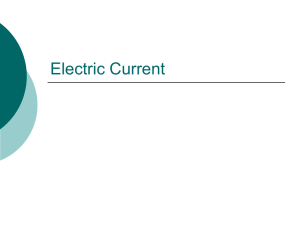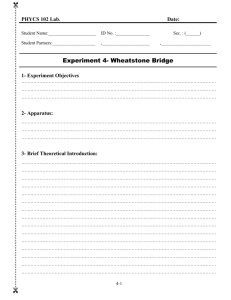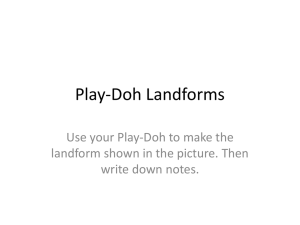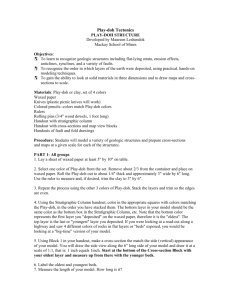Play-Doh Resistance LP - 2010-ComprehensivePortfolio
advertisement
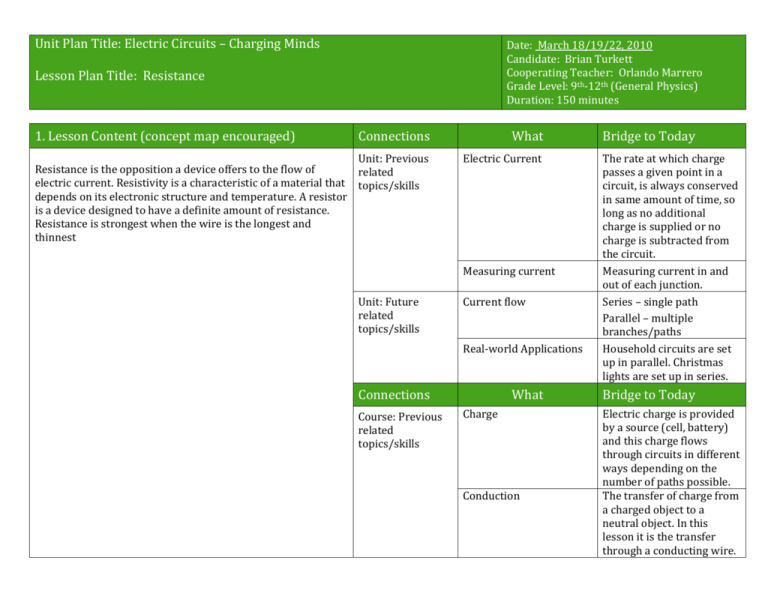
Unit Plan Title: Electric Circuits – Charging Minds Date: March 18/19/22, 2010 Candidate: Brian Turkett Cooperating Teacher: Orlando Marrero Grade Level: 9th-12th (General Physics) Duration: 150 minutes Lesson Plan Title: Resistance 1. Lesson Content (concept map encouraged) Connections What Unit: Previous Resistance is the opposition a device offers to the flow of related electric current. Resistivity is a characteristic of a material that topics/skills depends on its electronic structure and temperature. A resistor is a device designed to have a definite amount of resistance. Resistance is strongest when the wire is the longest and thinnest Electric Current Measuring current Unit: Future related topics/skills Current flow Real-world Applications Connections Course: Previous related topics/skills What Charge Conduction Bridge to Today The rate at which charge passes a given point in a circuit, is always conserved in same amount of time, so long as no additional charge is supplied or no charge is subtracted from the circuit. Measuring current in and out of each junction. Series – single path Parallel – multiple branches/paths Household circuits are set up in parallel. Christmas lights are set up in series. Bridge to Today Electric charge is provided by a source (cell, battery) and this charge flows through circuits in different ways depending on the number of paths possible. The transfer of charge from a charged object to a neutral object. In this lesson it is the transfer through a conducting wire. Course: Future related topics/skills Thermodynamics Temperature of a wire. Microphones Sound pressure changes the position between a metallic membrane and solid back plate. Charging happens due to waves changing these separations. 2. Goals 1. Students will understand that resistance is affected by the length of a wire, the cross-sectional area of a wire, and the material of the wire. 2. Students will understand that the highest resistance will come from the longest and thinnest wire, so long as the material is the same. 3. Students will understand that the current, potential difference, and resistance are related by Ohm’s Law. “Big Idea”: Resistance is the opposition to the flow of electric current. Expected stumbling blocks . . . Resistivity Addressed How? Students will have trouble understanding the resistivity of a wire. Resistivity charts will be provided on example pages and practice worksheets. Students will have trouble analyzing proportions such as doubling the length or area of a wire, and its impact on resistance. Multiple examples will be provided. Proportions 3. Objectives (Given X, SWBAT Y, as demonstrated by Z) 4. NYS/National Standards (cut and paste complete standard) 1. Given a can of Play-doh, students will be able to vary the length and area of the Play-doh and measure the current and voltage of the Play-doh in a circuit using a multimeter. 4.1l All materials display a range of conductivity. At constant temperature, common metallic conductors obey Ohm’s Law. Connections (described) Students will be measuring the length and calculating the area of their Play-doh 4.1m The factors affecting resistance in a conductor are cylinders. They will also be length, cross-sectional area, temperature, and resistivity. measuring the voltage and Process skills: ix. use measurements to determine the resistance of a circuit current that runs through there Play-doh. This data element x. interpret graphs of voltage versus current will help them to xi. measure and compare the resistance of conductors of understand resistance with various lengths and Assessments (e.g. quiz, HW) Play-doh Lab regards to the conductivity of the Play-doh. cross-sectional areas 2. Given Regents questions and a calculator, students will be able to calculate resistance, resistivity, length, or cross-sectional area using the resistance equation, as demonstrated by Mr. Turkett in example problems. 5. Assessment Attached (name [ F or S]) 4.1m The factors affecting resistance in a conductor are length, cross-sectional area, temperature, and resistivity. What Counts (as evidence for understanding) Students will be provided Resistance/Resis with an equation and a chart tivity Worksheet of resistivities. From the information provided in the questions students will need to calculate resistance, resistivity, length of a wire, or the area of a wire. Example (sample student language) Play-Doh Lab [F] Students will have completed the graphs and made general statements that analyze their data results. These statements should reflect that current and voltage relate to each other directly, and that length and area affect the voltage and current of the Play-doh in some way. As voltage increases the current increases. Resistance/Resistivity [F] Students will have completed the worksheet and received at least a 6 out of 10. As the wire length is doubled the resistance doubles. As the area of the wire doubles the resistance halves. How will you use these results? These results will be used during discussion of resistance in the powerpoint. Students will offer what they found and we will discuss why their results might contradict or confirm what science holds as right. Students answers to the example questions will help me assess how well they understand my powerpoint slides, my explanations, and the concepts of resistance. This knowledge can be used to show that my approach helps their understanding, or that I may need to offer more reinforcement in future lessons. Resistance Powerpoint [F] Students will answer example questions that split up the topics in the presentation. The resistance is measured in ohms. Students answers to the example questions will help me assess how well they understand my powerpoint slides, my explanations, and the concept of resistance. This knowledge can be used to show that my approach helps their understanding, or that I may need to offer more reinforcement in future lessons. Formative Assessment Contribution to the Summative Assessment? Play-doh lab Resistance/Resistivity Resistance Powerpoint Provides graphical analysis of voltage and current as well as resistance vs. length and resistance vs. area. Allows students to calculate resistance, resistivity, length of a wire, or cross-sectional area of a wire. Provides graphical analysis of voltage and current as well as resistance vs. length and resistance vs. area. Allows students to calculate resistance, resistivity, length of a wire, or cross-sectional area of a wire. 6. Community Knowledge and Experience: In what specific ways do you “HEAR” student voices? Student voices will be heard through the sharing of their results of their Play-doh lab during the powerpoint. We will collectively assess why some students received different results from what science states and why others confirmed these results. Students will be able to offer their voice as well during the Play-doh lab as they are analyzing their graphs and data to understand what is happening in the Play-doh and circuit. How will you USE what you “HEAR”? These voices will be used to strengthen the concept of resistance and the nature of science. Students will see the importance of procedures and accuracy of data collection. How do you JOIN your students in shared experiences as a participant? I will join the students by helping them build graphs and scaling their axes. I will ask guiding questions to promote critical thinking of these results having students make statements surrounding the length and area of their play-doh and how this relates to their voltage and current. Time 7. Procedure/ Transitions Strategies for maximizing ontask engagement Obj. # (s) 8. Resources (what and how distributed) Back-up Plans 3 min Bellwork Day 1: If it takes 8 Joules of work to move a charge of 2 coulombs around a circuit, then what is the potential difference in the circuit? As students walk in the bellwork will be placed on the back table. Students will pick it up and work on the answering the question. When they have completed the question they will bring it up to the front of the room and place it in their respective class folder. 7 min Transition I will transition into explaining that today we are going to be starting a lab that uses Play-doh. The purpose of the lab is to roll the play-doh out into cylinders. You will be placing the play-doh into a circuit. We want to vary the length or thickness of the play-doh in each trial. You want to conduct four trials. For each trial you need to measure the current going into the play-doh, the voltage across the play-doh, the length between your voltage measurements, and the area of your cylinder. You will need to calculate area by measuring the diameter and using this equation to calculate the area. The materials you will need are listed on the smart board. We will be using 9 volt batteries so please be careful when connecting your circuits. Do not leave your circuit connected for more than a minute. This means you should be taking your voltage and current measurements simultaneously, or as quickly as possible. Bellwork sheets Powerpoint 3 wires 2 multimeters 2 nails 1 battery 1 Play-Doh color 1 Ruler 1 calculator If powerpoint is down, then bellwork will be written on the whiteboard. If bellwork sheets are lost then students can write their answer on a separate sheet for the day. 90 min 3 min Play-doh lab Bellwork Day 2: If you made a cylinder of PlayDoh and measured the diameter of the cylinder to be 2 cm, then what will the crosssectional area of the Play-Doh cylinder be? 3 min Bellwork This lab will take at least two full 1. class periods to finish. Students will need to make sure they are measuring length and diameter in centimeters and converting these measurements to meters. Area calculations will need to use the diameter of the cylinders. Voltage and current measurements should be made simultaneously and then the circuit should be disconnected in order to avoid burning the Playdoh and heating up the 9 volt battery. Students may need help with scaling their graphs and drawing best fit lines. As students walk in the bellwork will be placed on the back table. Students will pick it up and work on the answering the question. When they have completed the question they will bring it up to the front of the room and place it in their respective class folder. As students walk in the bellwork will be placed on the back table. Students will pick it up and work on the answering the question. When they have completed the question they will bring it up to the front of the room and place it in their respective class folder. 3 wires 2 multimeters 2 nails 1 battery 1 Play-Doh color 1 Ruler 1 calculator Play-doh lab Bellwork sheets Powerpoint Bellwork sheets Powerpoint If there is additional time, have students graph their data on a computer and have the computer draw a best fit line. If powerpoint is down, then bellwork will be written on the whiteboard. If bellwork sheets are lost then students can write their answer on a separate sheet for the day. If powerpoint is down, then bellwork will be written on the whiteboard. If bellwork sheets are lost then students can write their answer on a separate sheet for the day. 2 min Transition 30 min Resistance Powerpoint 1 min Transition I will transition into explaining that today we are going to be taking notes on resistance and resistivity. The play-doh in our lab acted as a resistor and so we want to understand what that means. I will then ask them to take out their notebooks. I will begin by explaining that the 2. resistor is the object (play-doh) that contributes the action of resistance due to the innate character of resistivity it possesses. This means that different wires have different resistances because they can be made up of different metals or have different shapes that affect resistance. In fact, play-doh colors have different resistivites which is probably caused by the metal characteristics in their dyes. I will then provide the students with the equation for resistance and we will look at graphs of resistance versus length and resistance versus area to understand that the highest resistance is when we have the longest and thinnest wire. We will then work on examples using this resistance equation. When you walked in you picked up a resistance and resistivity practice worksheet. Take that out and work on finishing that up for the remainder of class. When you are finished turn it into the class folder. 2. Powerpoint, notebooks, pen, calculator Resistance worksheets will be placed next to the bellwork at the beginning of class. 15min Resistance/Resistivity Students will work on a worksheet 2. Resistance/resistivity that asks them to calculate worksheet, pen, calculator, resistance, resistivity, length of a wire, or cross-sectional area of a wire. I will place a resistivity chart up on the smartboard for students to reference. What affordances and limitations if any have you considered with respect to resources (time, money, learning curve of equipment use, ect)? I have afforded two class periods for students to finish the play-doh lab. This gives them the time to learn how to graph their data accurately and analyze these graphs to understand the relationships of length, area, voltage, and current to resistance. 9. Applications, Connections and Extensions: What are you going to ask students to do that gives them a chance to use this new knowledge (should make connections, should go out of the classroom)? Students will be able to extend their knowledge that all appliances have some resistance. Household appliances possess some resistance inside all of them. The calculators the students are using also use resistance. Students can connect resistance to the idea of a four way highway moving into one lane, or a pipe decreases its diameter. Students can apply their knowledge of resistivity to why certain metals are used for circuits and appliances. 10. Inclusive Instruction: How are you meeting diverse student needs (e.g. multiple modalities, small group work, culturally diverse examples)? The lab will be completed in small groups and the worksheet provides both graphical as well as written explanations and answers. The lab also requires the use of technology and physical manipulation of materials. If students can complete either the graphical or written assignment alone, then this could be enough for me to assess their learning and understanding of the material and areas that may need reinforcement. Profile three students who represent unique needs in your class (IEP’s, ESL, enrichment, marginalized students) AND describe how you will meet their needs. 1. Amina Zatar Amina is an ESL student and may need some extra help understanding the language. I provided visuals on the sheet to help her see what the words are describing. If she requires more assistance Mr. Marrero can 2. Cyd Marie Rodriguez – ESL (Spanish speaking) I have provided picture aids in most of my documents with arrows that point to the necessary steps in order to layout a visual aid for those students who cannot read English 3. Jemere Singleton Jemere needs to be separated from some of the students in the classroom. He has been working with one student really well and I am continuing to place those two together. If this partner of his is absent one of the days then translate for her, or I will walk her through the instructions. well. I also have her working with a group of boys who understand the material well and are good at communicating with her. Jemere rarely does his work and causes disruptions. On these days he needs more of my one on one attention and aid. 12. Safety What are your safety considerations? Students will be using 9 volt batteries. Students are to make sure that when using these batteries they do not leave them connected to a circuit for too long. All measurements should be taken simultaneously so that circuits can be disconnected immediately after measurements are recorded. If students leave the batteries connected for too long they could become hot and burn the play-doh or damage the wires. How will you know the students understand the safety procedures? I will provide detailed instructions prior to each of the activities and ask after each of my instructions whether anyone has any questions. I will also ask for confirmation through yes/no or thumbs up/down or head shakes whether people get the activities. 11. Reflections How did you construct a meaningful learning environment? This lesson extended the knowledge of current, conservation of charge, and voltage to resistance. Students participated in an inquiry based lab experiment that asked them to manipulate the length and thickness of Play-doh cylinders. The lab had them graphing, analyzing these graphs, measuring voltage, current, length, and calculating area and slope. There are numerous scientific standards that this single lab addresses. Furthermore the powerpoint provides a through discussion of the scientific knowledge of resistance upon which students could compare their results. This provided a fruitful dialogue of feedback and response that stimulated understanding and learning. What are the strengths and limitations of this lesson? The strengths of this lesson include the numerous scientific standards that the lab addresses. Students use measuring skills, calculating skills, graphing skills, and analyzing skills. There is also a sense of curiosity as to why we are connecting Play-doh into a circuit. The limitation of this lesson is the consistency in measuring and accuracy of student calculations and graphing. Another limitation of this lesson focuses on the idea of resistivity. Students found this concept hard to understand and did not understand why different Play-doh colors have different resistivities like different metals do. How could this lesson be revised? I will need to revise the lab statements. I want students to calculate V/I for each trial and not the slope of their graphs. Also I will need to include a section for students to record their diameters and then calculate area. The purpose of calculating rho could be stated as well. What insights have you learned about your students? I was really pleased to see how well my students could graph. A lot of my colleagues have found difficult in this aspect, and I decided to try it. My students did have trouble with creating a scale and drawing best-fit lines, but those issues were easily solved by having groups collaborate their knowledge and experiences. What insights have you learned about yourself? I learned that I like to try new things, and that I can adapt easily to any mishaps that happen in my lab write-up and still get great results from the students. Also, I’m really glad I included the graphs and had the students calculate resistance. I think the general class can handle all of this.




